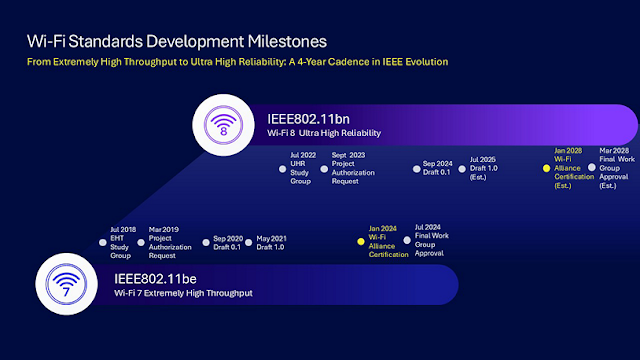Wi-Fi 8 (IEEE 802.11bn) Making Wireless More Stable for the Future
The new wave of wireless tech, Wi-Fi 8 (IEEE 802.11bn), is now focusing more on making sure wireless links do not fail, rather than just making them faster. A paper by IEEE states the standard will give "Ultra High Reliability" (UHR) by making clear, big changes.
The Main Goal Ultra High Reliability (UHR)
Even though Wi-Fi 8 will keep the top speed the same as Wi-Fi 7 (up to 23 GT/s), it aims to make links 25% better in key areas, even in hard places for wireless. These aims are:
- Better Speeds in Hard Spots: A 25% boost in speed for devices far from the center of the network or where the signal is bad.
- Less Lag in Bad Situations: A 25% drop in delay for the worst cases, helping fast-response uses like AR or factory work.
- Fewer Lost Links: A 25% cut in lost connections, mainly when moving between access points, making transfers smoother.
Building Blocks and New Parts
Wi-Fi 8 grows from what Wi-Fi 7 began, working in the 2.4, 5, and 6 GHz bands and using a wide channel (up to 320 MHz), high-quality modulation, multi-user tech, and efficient use of channels. To hit its UHR targets, the 802.11bn will bring in new parts like:
- Coordinated Spatial Use (Co-SR)
- Coordinated Beam Aim (Co-BF)
- Flexible Sub-Channel Use (DSO)
- Improved Modulation Coding (MCS)
How Wi-Fi 8 Can Be Used
The sure links of Wi-Fi 8 will help many places:
- Work and Factories: Keeping important gear like self-moving cars and smart robots linked without break.
- Public Spots: Better use in airports, sports places, and malls for things like AR maps, live videos, and key security jobs.
- In the Home: More stable and strong links, really helping in packed living areas with many networks.
When to Expect Wi-Fi 8
The plan to bring out the Wi-Fi 8 standard is set for the next few years:
- First Draft: Coming soon, laying down main parts for makers.
- Wi-Fi Group Approval: Set for January 2028, to start testing how different products work together.
- Final IEEE Okay: Aimed for March 2028, making the standard official.


